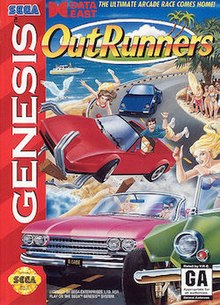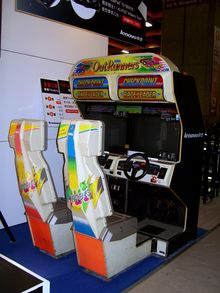OutRunners
| OutRunners | |
|---|---|
 Sega Genesis cover box art | |
| Developer(s) | Sega AM1 |
| Publisher(s) | Sega[a] |
| Composer(s) | Takayuki Nakamura Takenobu Mitsuyoshi Hiroshi Kawaguchi |
| Series | Out Run |
| Platform(s) | Arcade, Sega Genesis |
| Release | Arcade
|
| Genre(s) | Racing game |
| Mode(s) | Single-player, multiplayer |
| Arcade system | Sega System 32 Multi |
OutRunners (アウトランナーズ, Outorannāzu) is a 1993 racing video game developed by Sega AM1 on System 32 Multi hardware.[2][3] It constitutes the third release in the arcade Out Run series, after Turbo OutRun (1989), and was ported to the Sega Genesis home console in 1994.
Description

OutRunners is the fourth game in the Out Run series, following Battle Out Run and Turbo Outrun. After Turbo Outrun's departure from Out Run's laid-back, charming atmosphere, fans wanted a game that captured the spirit of the original. OutRunners succeeded in doing this; it brought back the ability to take different paths through forks in the road, returned to a lighthearted atmosphere, and distanced itself well from the "serious" Turbo OutRun. The game featured head-to-head support, and with enough cabinets, up to eight players could challenge each other. It was also the only game in the Out Run series to feature various selectable cars and multiple endings until OutRun 2. OutRunners was the most successful game released for Sega's System Multi 32 hardware, and one of the last successful 2D games released by Sega. OutRunners was also known for having some of the best looking graphics seen at the time, thanks to creative sprite design and a skillful use of parallax scrolling, similar to that found in Power Drift, released four years earlier.
Some routes are accessible on more than one route combination like in the original Out Run. After the initial starting stage, the player has the option of either turning east or west. West leads through San Francisco, through the Easter Islands, into Asia and either into Africa or Europe. East goes through the Grand Canyon, South America or Niagara Falls, across the Atlantic Ocean, into Europe and either into Asia or Australia.
An anthropomorphic broad bean character is featured on billboards and the start of the game called "Broad Bean", a parody of Bibendum (the Michelin man), presumably the mascot of the fictional company sponsoring the race, Sam Spree. In the Mega Drive version, both Sonic and Tails may fly by in a pair of Tornados and sprinkle the Sega logo onto the screen. Sonic can also be seen on various billboards in the first stage.[4]
All of the selectable cars in OutRunners are fictional convertibles, but bear resemblance to real automobiles. Notably, the Speed Buster closely resembles the Ferrari Testarossa featured in the original Out Run. Each car has its own set of characters, consisting of a driver and a passenger, complete with their own unique ending vignette if the player makes it to a goal. Each character set also has their own way of acting when their car crashes (flying through the air, bouncing like balls, running after the car, etc.), but unlike their Out Run counterparts, they always land right back into the car on the wheels and keep going as if nothing had happened.
Development
OutRunners features all four of the songs from the original OutRun by Hiroshi Kawaguchi, as well as various new tracks composed by Takenobu Mitsuyoshi and Takayuki Nakamura, along with contributions from Kawaguchi.
Release
A port of the game was released for the Mega Drive by Sega and for the Genesis by Data East. It featured a forced split-screen in single player modes, where one screen focused on the player and the other on the AI. Though the graphics were merely an adaptation of the arcade version, all other features of this version were kept intact, such as the original arcade soundtrack featuring four songs from the original Out Run. Andy Dyer wrote in Mega that it was "the most embarrassing driving game to appear on the Mega Drive".
In October 1993, Atari Corporation filed a lawsuit against Sega for an alleged infringement of a patent originally created by Atari Corp. in the 1980s, and Atari sought a preliminary injunction to stop manufacturing, usage, and sales of hardware and software for the Genesis and Game Gear. On September 28, 1994, both parties reached a settlement involving a cross-licensing agreement to publish up to five games each year across their systems until 2001. The Genesis version is one of the first five games approved from the deal by Sega in order to be converted for the Atari Jaguar, but it was never released.[5][6]
Reception
In Japan, Game Machine listed OutRunners on their July 1, 1993, issue as being the most-successful upright/cockpit arcade unit of the month.[9] It went on to be Japan's fourth highest-grossing dedicated arcade game of 1994,[10] and tenth highest of 1995.[11]
In North America, Play Meter listed it to be the seventh most-popular arcade game in October 1993,[12] and then the top-grossing deluxe arcade game in November 1993.[13] It ended the year as one of America's top seven best-selling arcade games of 1993, for which it received a Gold award in sales achievement from the American Amusement Machine Association (AAMA).[14]
Online version
In May 1993, one year after its arcade release, Sega of Japan demonstrated an online game version of OutRunners, allowing up to eight players to play the game across two different cities in Japan. It was the first online arcade game to be demonstrated, with two separate OutRunner four-player cabinets connected in Tokyo and Osaka connected online via an Integrated Services Digital Network (ISDN) operated by Nippon Telegraph and Telephone (NTT). Sega announced plans for a Japanese release in July 1993. One month later, AT&T announced plans with Sega of America to introduce a similar online console gaming system for the Sega Genesis.[15]
Notes
References
- ^ "アーケードTvゲームリスト国内•海外編(1971-2005)". 2005.
- ^ "Out Runners". Killer List of Videogames. Retrieved November 10, 2013.
- ^ "Out Runners(アウトランナーズ) – 株式会社セガ". セガ・アーケードゲームヒストリー|株式会社セガ (in Japanese). Retrieved November 6, 2021.
- ^ "Cameos & Related Games". Archived from the original on February 20, 2008. Retrieved March 5, 2008.
- ^ CRV (August 6, 2017). "Blog:Legal Brief: Atari vs. Sega". gdri.smspower.org. Archived from the original on November 16, 2018. Retrieved November 15, 2018.
- ^ "Flashback: The Atari Jaguar Almost Got Shinobi, Streets of Rage, Wonder Boy and Other Sega Classics". April 26, 2023. Archived from the original on May 24, 2024.
- ^ Lawrence of Arcadia (August 1994). "ProReview: OutRunners". GamePro. No. 61. p. 44.
- ^ Mega review, issue 22, page 47, July 1994
- ^ "Game Machine's Best Hit Games 25 – アップライト, コックピット型TVゲーム機 (Upright/Cockpit Videos)". Game Machine (in Japanese). No. 452. Amusement Press, Inc. July 1, 1993. p. 25.
- ^ "Best Videos '94: "Puyo Puyo", "Ridge Racer" DX" (PDF). Game Machine (in Japanese). No. 487. Amusement Press, Inc. January 1–15, 1995. p. 36.
- ^ ""Virtua Fighter 2" and "Virtua Cop" Top Videos" (PDF). Game Machine (in Japanese). No. 511. Amusement Press, Inc. February 1, 1996. p. 22.
- ^ "Equipment Poll – Video & Pinball Combined". Play Meter. Vol. 19, no. 11. Skybird Publishing. October 1993. p. 8.
- ^ "RePlay: The Players' Choice". RePlay. Vol. 19, no. 2. November 1993. p. 10.
- ^ "ACME '94: Play Meter, AAMA salute best games". Play Meter. 20 (5): ACME 73–4. April 1994.
- ^ "Sega Phone-Links Games: interactive coin-op gameplay demo'd between Tokyo and Osaka; Sega home video will have similar capabilities in the USA". RePlay. Vol. 18, no. 12. September 1993. pp. 43–4.
